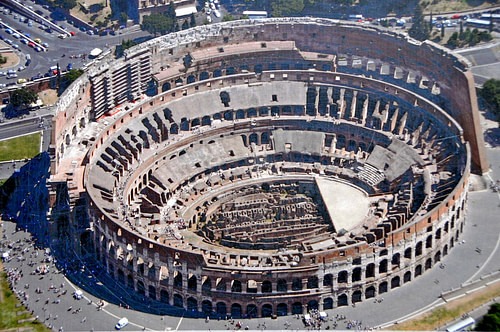The Colosseum, an architectural marvel and enduring symbol of ancient Rome, stands as a testament to the ingenuity, engineering prowess, and cultural legacy of one of history’s greatest civilizations. This iconic amphitheater, with its rich history and imposing presence, continues to captivate visitors from around the world, offering a glimpse into the grandeur and spectacle of ancient Roman entertainment.

Historical Background
Constructed between 70-80 AD under the Flavian dynasty, the Colosseum, originally known as the Flavian Amphitheater, was commissioned by Emperor Vespasian and completed by his son Titus. Built on the site of Nero’s extravagant palace, Colosseum served as a venue for public spectacles, including gladiatorial contests, animal hunts, mock naval battles, and dramatic performances, entertaining crowds of up to 50,000 spectators.
Architectural Marvel
The Colosseum’s architectural design is a masterpiece of Roman engineering and innovation. Standing 48 meters tall and spanning an area of 6 acres, the amphitheater is an imposing structure characterized by its elliptical shape, towering arcades, and tiered seating arrangement. Constructed primarily of travertine limestone and concrete, Colosseum’s intricate system of arches, vaults, and corridors facilitated the flow of spectators and performers and ensured the structural integrity of the building.
Symbol of Spectacle and Entertainment
During its heyday, the Colosseum was the epicenter of public entertainment in ancient Rome, hosting a wide array of events and exhibitions that captivated audiences and showcased the prowess and extravagance of Roman society. Gladiatorial combat, in which trained fighters battled to the death, was among the most popular spectacles held at the Colosseum, attracting spectators from all walks of life and reinforcing the values of courage, honor, and martial prowess.

Enduring Legacy
Despite centuries of neglect, natural disasters, and plundering, the Colosseum has endured as a symbol of resilience and endurance, bearing witness to the passage of time and the ebb and flow of history. Today, Colosseum stands as a UNESCO World Heritage site and one of the most visited tourist attractions in the world, drawing millions of visitors each year who come to marvel at its architectural splendor, explore its labyrinthine corridors, and reflect on its profound historical significance.
Preservation and Restoration Efforts
In recent years, efforts have been undertaken to preserve and protect the Colosseum for future generations. Restoration projects aimed at stabilizing the structure, repairing damage, and enhancing visitor experiences have been carried out, ensuring that this ancient wonder continues to inspire awe and admiration for centuries to come.
As a symbol of ancient Rome’s power, grandeur, and cultural legacy, Colosseum stands as a timeless testament to human ingenuity and achievement. From its origins as a venue for public spectacles to its status as a global icon of architectural excellence, the Colosseum continues to captivate the imagination and inspire wonder, reminding us of the enduring legacy of one of history’s greatest civilizations.
Exploring the Merits and Drawbacks of the Colosseum: An Analysis of Ancient Rome’s Iconic Amphitheater
The Colosseum, an architectural marvel and enduring symbol of ancient Rome, boasts a rich history and cultural significance that continues to captivate visitors from around the world. While celebrated for its grandeur and historical importance, the Colosseum also presents certain challenges and considerations that warrant examination.

Advantages of the Colosseum:
- Historical Significance: The Colosseum stands wdbos as a tangible link to ancient Rome’s vibrant culture and history. As a venue for gladiatorial contests, mock battles, and public spectacles, it played a central role in Roman society, reflecting the values, traditions, and entertainment preferences of the time.
- Architectural Marvel: Renowned for its innovative design and engineering ingenuity, the Colosseum is a testament to the architectural prowess of ancient Rome. Its elliptical shape, towering arcades, and tiered seating arrangement demonstrate the Romans’ mastery of construction techniques and their ability to create monumental structures that have stood the test of time.
- Cultural Heritage: Designated as a UNESCO World Heritage site, Colosseum is recognized for its cultural significance and contribution to humanity’s shared heritage. It serves as a focal point for education, research, and cultural exchange, attracting scholars, historians, and tourists who seek to learn about ancient Rome and its enduring legacy.
- Tourism and Economy: The Colosseum is a major tourist attraction and a significant source of revenue for the city of Rome and the surrounding region. Millions of visitors flock to the Colosseum each year, generating income for local businesses, hotels, restaurants, and tour operators, thereby contributing to the economy and supporting livelihoods.
Disadvantages of the Colosseum:
- Degradation and Decay: Despite its enduring legacy, Colosseum has suffered from centuries of neglect, weathering, and environmental damage. Erosion, pollution, and natural disasters have taken their toll on the structure, leading to deterioration and structural instability that threaten its long-term preservation.
- Overcrowding and Overtourism: The popularity of the Colosseum as a tourist destination has led to issues of overcrowding and overtourism, particularly during peak seasons. Large crowds can detract from the visitor experience, diminish the monument’s aesthetic appeal, and pose challenges in terms of visitor management, safety, and conservation.
- Vandalism and Theft: The Colosseum has been subject to acts of vandalism, graffiti, and theft over the years, resulting in damage to the monument and loss of valuable historical artifacts. Unauthorized access, lack of security measures, and insufficient monitoring have made the Colosseum vulnerable to vandalism and illicit activities.
- Accessibility and Conservation: Accessibility issues, including limited facilities for visitors with disabilities and inadequate infrastructure, can hinder the overall visitor experience and prevent full enjoyment of the site. Additionally, conservation efforts aimed at preserving Colosseum’s architectural integrity and historical authenticity require ongoing funding, expertise, and collaboration to ensure success.
Conclusion:
While the Colosseum boasts undeniable merits as an iconic symbol of ancient Rome and a UNESCO World Heritage site, it also presents certain challenges and drawbacks that require careful consideration and management. By addressing issues related to conservation, overcrowding, vandalism, and accessibility, stakeholders can work towards preserving the Colosseum’s legacy for future generations while ensuring that it remains a source of inspiration, education, and cultural enrichment for all.
Read More Article About “Feathered Gold: How Sustainable Farming Is Revolutionizing Grilled Chicken“


























